originally posted at https://canmom.tumblr.com/post/681535...
Hi friends it’s Animation Night! Numerologically speaking, 101 is the number usually assigned to introductory courses at American universities, and also the string 101 represents the number 5 in binary. Does this mean anything? …No.
Tonight I am minded to bring you a look at Wit Studio, the occasion being their release of an hour-long adaptation of The Girl from the Other Side: Siúil, a Rún (とつくにの少女), a haunting and unusual manga by a mangaka known only as Nagabe. The adaptation has caught a lot of attention thanks to its unusual visual style, capturing the beautiful, textured lines and muted colours of Nagabe’s artwork. Here, take a little look, here’s the title page of the manga…

and here’s a still from the film:
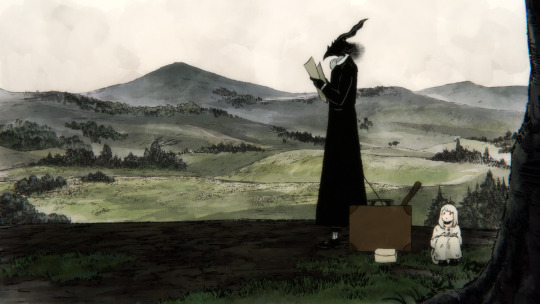
In high definition you can especially see how closely they match the manga’s style.
The manga concerns a young girl living in a deserted world, under the care of a strange horned creature that she refers to as her teacher. Over the first couple chapters, we gradually learn that Teacher belongs to a cursed people, and the village has been evacuated to protect its people from their curse; the girl, left behind, is in their care, but Teacher cannot bring themselves to tell the truth. Meanwhile, soldiers are being sent to investigate… but most of the moment to moment scenes in the manga see Teacher and the girl quietly spending time - chopping firewood, serving tea parties with scavenged tea, and existing together. But between soldiers sent to investigate and contain the curse, and the less friendly cursed creatures from the forest, and the girl’s efforts to find her grandmother (or auntie, depending on translation), it cannot last…
The illustration style strikes an interesting balance between detail and simplicity. The girl herself is greatly abstracted, with the textured lines contrasting against the elegant simmplicity she’s drawn with; she’s also generally speaking almost all in white in contrast to the monster’s silhouette. The backgrounds are where the detail comes out, full of intricate hatching and dark and light tone. The effect is overall very assured - perhaps it’s just me, but I am reminded in a way of Houseki no Kuni. Sadly the existing scanlations of the first few volumes are… kinda awkwardly translated.
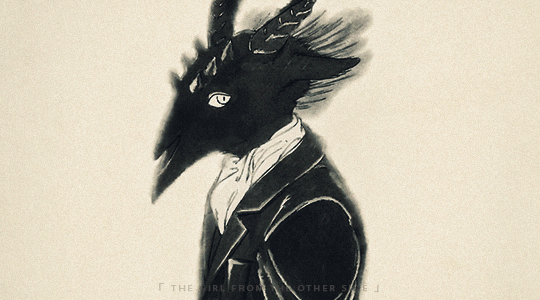
This adaptation is the second time Wit has adapted the manga, an expansion of their original 10 minute video. Both were released alongside special editions of the manga. More on that in a bit, but first, some introductions are in order! Who are Wit Studio, what’s their deal?
Founded in 2012, they’re a spinoff of Production I.G. founded by George Wada, the producer for many I.G. works. I’m not sure I entirely understand the circumstances of their founding, since Wada did not leave I.G., and continued to produce works like Psycho-Pass in addition to directing Wit. Regardless, the studio’s initial staff were generally I.G. veterans, and the two studios continue to work closely together.
Their first production seems to be the film Hal, directed Ryōtarō Makihara, an hour long story of a robot attempting to comfort a bereaved woman by taking the appearance of her husband. The film received praise for its artwork, although apparently hampered by its restricted runtime.

They leapt to prominence pretty quickly with Tetsurō Araki (known for the Death Note adaptation and uh, High School of the Dead, mostly known for perhaps one of the most infamous boob scenes in anime history lmao) alongside Masashi Koizuka directing an adaptation of Attack on Titan (進撃の巨人) by Hajime Isayama, a military-gothic horror manga that is… troubling to talk about. The author and manga have become subject of significant controversy due to his nationalist politics, and how evident it may be in the work itself.
Attack on Titan is set in a dystopian world in which humans live in a series of giant walls designed to keep out the ‘Titans’, huge, oddly-proportioned giants which have a predilection for eating people. When a massive titan appears and breaches the walls, we follow our protagonists fighting a desperate retreat into the inner walls, ruled by a corrupt nobility who will happily sacrifice thousands of soldiers and civilians alike. However, a chance to fight back comes when the main protagonist, a weak boy who has the hilarious name “Eren Jaeger”, discovers the ability to transform into a Titan himself, with a rather striking écorché appearance, while remaining control of his faculties. He becomes part of a push back against the titans, but there’s something afoot; the giant titan which smashed the wall was one of these transforming humans like Eren.
The Titans themselves serve as something inbetween ‘groteseque monster’ and ‘meat mecha’, and judging by clips I’ve seen, more characters get to transform in later seasons as… whatever happens, happens.

(I don’t know which season this shot is from, I just find the face drawings funny. Don’t shoot me if it’s in a season by Mappa and not Wit! ;p )
There’s no question it’s fascinated with hot young men in uniform going off to die terribly in war for a corrupt political class, a story certainly open to a nationalist reading. The specific charges relate to the author’s statements on Japanese history, including a tweet defending the Japanese occupation of Korea (which saw systematic rape of Korean ‘comfort women’ by soldiers) by contrast to the Nazis, and a blog post in which he explained that a character in the manga was based on a turn-of-the-century Japanese general who was present at the Port Arthur Massacre during the First Sino-Japanese War. From there it seems to have became popular received wisdom that Isayama is a rabid nationalist who wrote the work as essentially Nazi propaganda.
The reality seems to be a little more complicated than that; I think it’s probably most accurate to say that the story follows the strong current of fascination with military and fascist imagery in otaku culture, particularly in its German flavours. Like many such works, ends up somewhere thoroughly unexamined and careless in the way it approaches subjects like the Holocaust and antisemitic conspiracy theories, but I would be surprised if it really was written as conscious propaganda. I don’t mean this to especially defend the author; at best he doesn’t seem like a very interesting man.
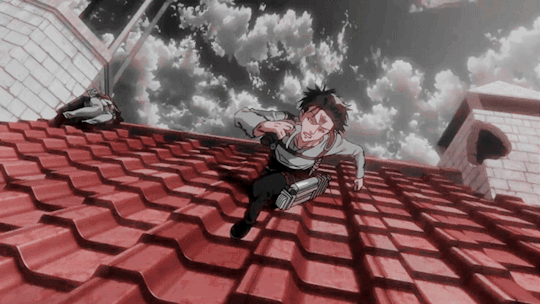
Still, however troubling and fashy the source material, Wit’s adaptation was exceptional. They brought an instantly-memetic OP and a really groundbreaking approach to action, led by the iconic key animator Arifumi Imai who took Ichirō Itano’s ideal of a flying action camera that moves fluidly from closeup to long shot and back (c.f. Animation Night 64) and pushed it to some real extremes with the help of CG background compositing. Outside of these flashy sequences, the direction tended to emphasise closeups on very detailed, carefully drawn figures over lively character animation, which can feel very dry but does call to mind a ‘manga’ feeling - if perhaps not the actual manga it’s adapting lmao.
The ‘3D manoeuvre gear’ used by the series’s protagonists proved a perfect fit for this style, and its mix of bleak soldierly desperation, gradual teasing of mysteries (surprise: the wall is full of big titans! betcha didn’t see that coming), and Imai’s action sakuga proved so compelling that it became a massive hit almost instantly, flooding scifi/anime conventions with cosplayers in the iconic cropped brown jackets. Over the subsequent nine seasons, it continued to be a wildly popular franchise, although its popularity gradually declined. Most recently, Attack on Titan eventually left Wit’s hands, going to the reckless and overburdened Mappa; it was apparently from the start a troubled and intensely demanding production.
So, that’s probably the biggest association of Wit Studio; their second is another military gothic work Kabaneri of the Iron Fortress, this one an original production also directed by Tetsurō Araki. The main thing I know about it is well,
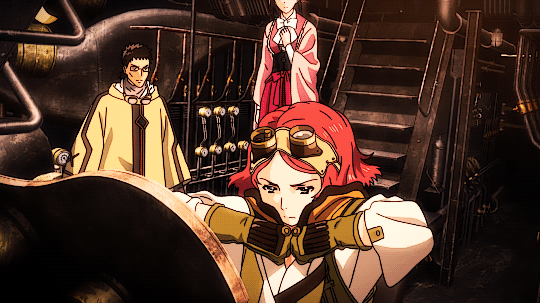
…this shot lmao. Alas, nobody seems to have uploaded it to Sakugabooru, so I can’t tell you who drew this fantastic set of muscles.
Kabaneri is a kind of dieselpunk zombie story as far as I can understand; it follows the story of two characters who survive infection with the kabane virus, becoming kabaneri (かばね人, literally something like ‘corpse people’), on the run after their city has been destroyed. It’s got a lot of bolt action rifles and rooftop action scenes, and was produced concurrently with AoT.
In terms of technique, the most notable novelty in Kabaneri was what Wit termed ‘makeup animation’, essentially doing digital paintovers of certain relatively static shots late in the production process, after the inbetweening, ink and paint, composite etc. were done. kVin posted some examples:
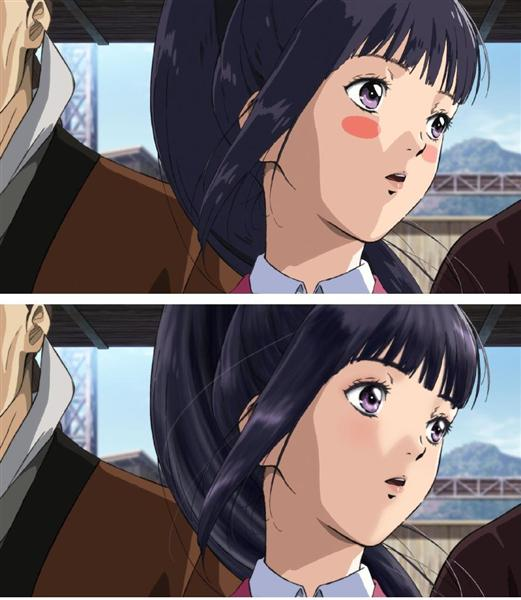
This process seems to mean softening out some of the specular highlights and blushes and adding shading detail to eyes and hair. Honestly I don’t like it all that much; sotening the edges of the shadow shapes seems like it’s in a weak middle ground between a truly painted style and cel shading, and it’s only practical with very limited animation! But it’s a thing that they did. Beyond that, my usual sources are pretty quiet on Kabaneri - it seems to have been a passion project for Araki, and yet it didn’t find an audience on the scale of Attack on Titan.

Wit’s latest hit is Ranking of Kings (王様ランキング), a delightful adaptation of Sōsuke Tōka’s story of a deaf-mute prince Bojji thrown into political intrigue and alchemical schemes when his gigantic father Boss dies. Luckily, he’s accompanied by a tiny shadow creature Kage who becomes completely charmed with the young prince’s straightforward kindness; the story simultaneously follows these two underdogs and the various schemes being pursued around them.
What sets it apart is an ability to be constantly surprising - rarely do things go the way I’d expect, characters can seem sympathetic and then revealed to be unsympathetic and then built back up as sympathetic once more - and a confidence reaching for high emotional stakes accompanied by a nonchalant sprezzatura in how it delivers its story. The art is bright and cheerful but definitely reaches into the more interesting side of medieval imagery with its alchemy and weird looking armour that would be at home in Dark Souls. The character designs add volume to the manga allowing more complex 3D staging while retaining their charm and simplicity. And while we can definitely see Imai’s hand showing in the more elaborate fight scenes, it really feels like an anime from an entirely different timeline - or perhaps an appeal to nostalgia to a generally less familiar tradition (kVin cites Popolocrois Monogatari as an influence).
kVin has a couple of very good writeups on its production, so in the interests of time, let me just leave those links and move on ^^
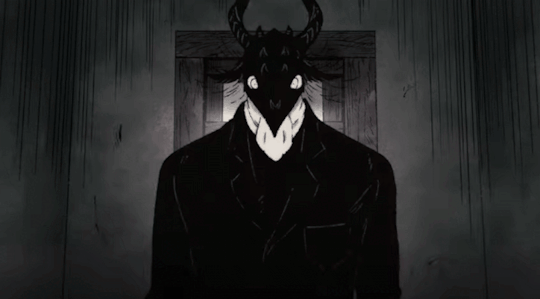
This, however, only represents one strand of Wit. Although it’s under the Wit name, this adaptation of The Girl from the Other Side actually specifically originates in a specific substudio, based in Ibaraki, one of four different branches. This one traditionally focuses on short films and training younger animators as well as supporting independent animation. They previously worked on Wit’s pokémon film, The Power of Us (2018), part of a kind of series reboot which focused more on a kind of slice of life approach to people living with pokémon. Given that Wit are credited on a number of music videos, including videos for Eve including We’re Still Underground and This World To You, I wonder if perhaps that’s also the work of this substudio, but I honestly have no idea.
In any case, kVin writes the key people behind at least the first 10-minute OVA are Yutaro Kubo and Satomi Maiya, who between them directed, storyboarded and even did most of the animation. This duo are apparently indie animator darlings, known for work like the music video for Tarareba by amazarashi which also puts a great deal of emphasis on line texture. I suspect they can’t have completed the same feat for the hour-long version, but honestly I can only speculate.
Perhaps the other production of note here is The Ancient Magus’ Bride (魔法使いの嫁), adapted from a manga by Kore Yamazaki, written for the same publisher as The Girl From the Other Side and sharing a… distinctly similar aesthetic approch lets say. Magus tells the story of a woman who is bought from slavery by a wizard with a skull for a head who takes her back to the mysterious magical land of Great Britain (lolll), and then follows her life with this creature who wishes to eventually marry her. It sounds like a spicy fantasy for D/s wizardfuckers but I think the actual approach was a bit more reserved and gentle; the project was adapted first as a three-episode prequel OVA, and then subsequently a full TV series, both directed by Wit’s Norihiro Naganuma at their Kichijoji Studio (formerly Wit Studio 4).
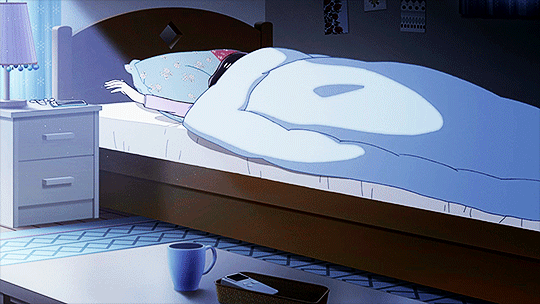
Alongside this we might talk about After the Rain (2018), adapting Jun Mazuyumi’s manga of a injured high school girl getting a crush on a much older restaurant manager. I know basically nothing about this, but kVin-senpai called it “the surprise of the season, after turning a thorny premise into a tactful look at an adolescent looking for a new reason to be.” I have basically run out of time at this point, so if that sounds interesting, please go check out kVin’s article.
Finally we should mention The Empire of Corpses (2015) - but just mention it because, well, I intend to do an Animation Night on Project Itoh and that’s one of the three works I’ll show then!
Overall, what is there to say of Wit? We can see the Production I.G. lineage in a number of ways: the very detailed, solid perspective drawings combined with somewhat limited animation in scenes of exposition and character acting, the emphasis on mecha and body horror imagery, and the comfort with CG compositing all evidently grew out of 90s and 2010s Production I.G. habits. But I think Wit also perhaps did a lot to define the current era of anime, and set the trend towards high spectacle and heavy digital filtering that would be carried further in, for example, Ufotable’s work (c.f. Animation Night 60).
Unfortunately, the other habit they carried forward from Production I.G. was intense overwork and tough conditions for animators. kVin wrote:
Unless a change of leadership happens at a higher level, it’s unlikely that the studio’s actual problems — chronically bad schedule management, unhealthy work attitude — will be reduced… and yet it’s hard not to be optimistic about this new branch of theirs [the Ibaraki branch], which is already yielding positive results.
Anime is, as has been said so many times, long overdue for a reckoning on work conditions, but there remain endless structural barriers to this happening. There’s no avoiding the fact that animation takes an enormous amount of work to pull off, but desperately tight schedules and a culture that encourages massive overtime and no life beyond work are absolutely not inevitable. But anyway, sermon over, let’s watch what they made.
Tonight I have for you a somewhat eclectic selection of more or less standalone Wit works. Our main features will be The Girl From the Other Side (both the original OVA and the new film) and Hal (2013), but I also intend to give tasters of some of Wit’s other works including a couple episodes of AoT to see how well it holds up in 2022, and the prequel OVA for Magus Bride.
If that sounds fun, please come and join me over at https://twitch.tv/canmom! We’ll be starting shortly!
Comments